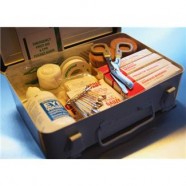Getting Prepared for Earthquakes
Posted by Admin Admin on Sep 4, 2014 in Blog, Featured News | Comments Off on Getting Prepared for Earthquakes

California has experienced some of the highest magnitude earthquakes in the United States! For those who lived through the San Francisco Earthquake of 1989 or the Northridge Earthquake of 1994, it was an unforgettable experience. It’s a moment that stays with you forever as you remember the devastation and loss that occurred on those days.
Luckily, at a recent National Earthquake Conference in Long Beach, seismologist Lucy Jones stated, “You’re about as likely to be shot by a toddler as you are to die in an earthquake.” Especially, if you’re prepared.
As we know, earthquakes are essentially unpredictable and strike without warning. Therefore, it is important to have a safety plan prepared. Here are the steps we recommend to be prepared and remain safe before, during and after an earthquake.
Before an Earthquake
- Pack a small emergency kit at work. Include items such as food, water, toiletries, a flashlight, and batteries to last for up to 72 hours.
- Review the Emergency Action Plan as outlined in your employee safety manual, or ask Human Resources about the protocol for earthquakes.
During an Earthquake
- If outside, move to a clear area free of poles or trees that may fall.
- If driving, pull over until shaking stops. Avoid overpasses and power lines.
- If inside, stay there. Seek shelter under a heavy table, or brace yourself inside a door frame.
- Stay at least 15 feet away from windows.
- If you use a wheelchair, lock the wheels if possible and cover your head with your arms.
- If you are safely able to do so, assist any co-workers that need extra help.
Don’t be surprised if the electricity goes out, if fire or elevator alarms begin ringing, or if the sprinkler system is activated. Expect to hear noise from broken glass, creaking walls and falling objects.
Immediately After an Earthquake
Remain in the same “safe” location for several minutes after the earthquake, in case there are any aftershocks. Once cleared, check for injuries and administer necessary first aid. Recognize and assist co-workers who are suffering from shock or emotional distress.
Implement your survival plan. Establish a temporary shelter if rescue teams are expected to be delayed. Use a stairway when instructed to exit the building.
To protect your home in an earthquake, consider getting earthquake insurance. Your homeowners insurance excludes losses due to an earthquake. Get in touch with us so we can chat about your current homeowners insurance policy and how earthquake insurance might be a good fit for you.
Print this Page | Contact us
